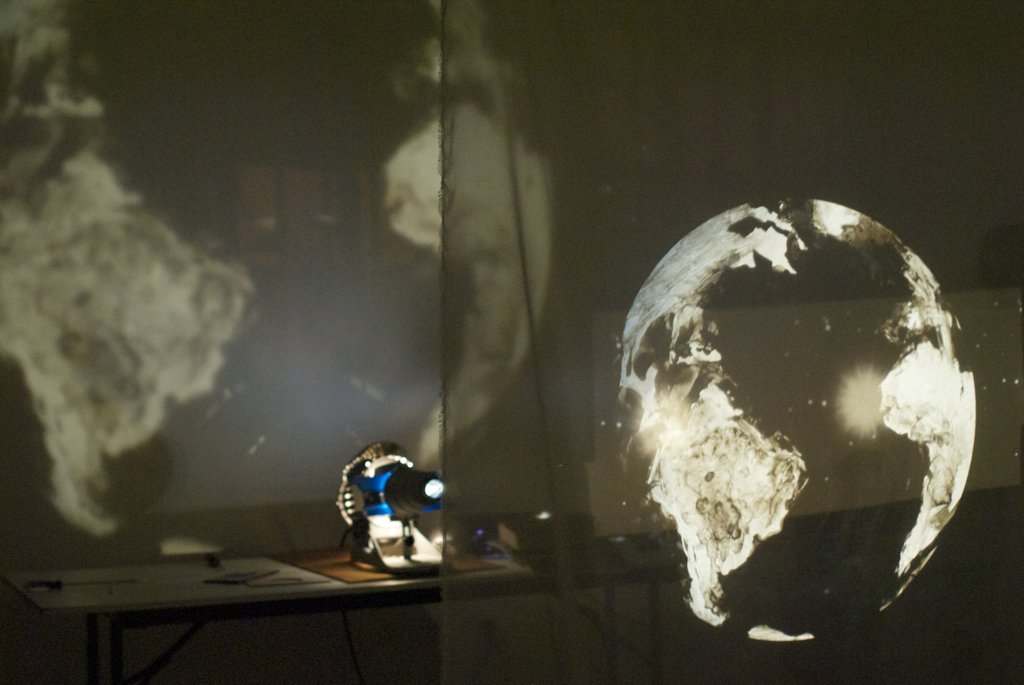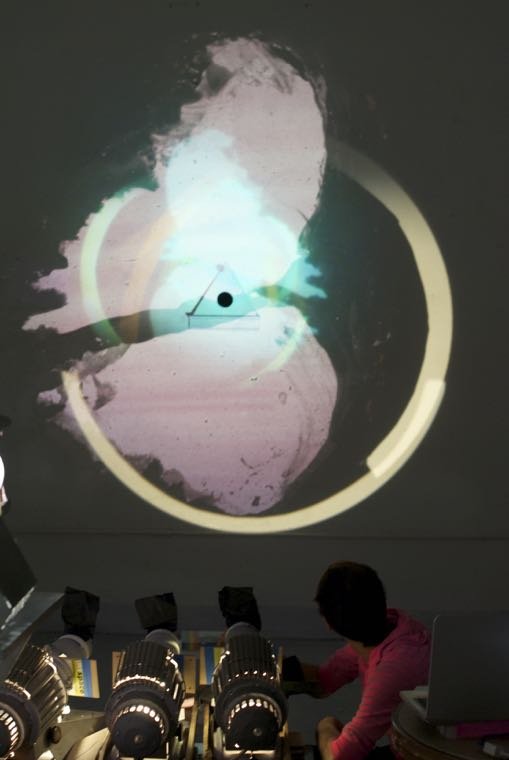Magic Lanterns
Why is it called a magic lantern? Part of my practice has been to revive and re-invent this quintessential (lensed) projection apparatus for contemporary use. An optical medium first documented in the 1420, the magic lantern enjoyed a centuries long history, only to be supplanted by film in the 20th century. But there were reasons for the magic lantern’s four centuries of longevity: its general usability, the jewel-like quality of its projections, its startling hand-operated charm, and its delightful affect.
In thinking through what a magic lantern for the 21st century might be, I came to concentrate on the particular qualities that distinguish it from digital projection, the dominant mode of viewing today. What follows is a basic outline of these distinguishing qualities of a magic lantern projection, in order to demonstrate the differences between a magic lantern and a digital system.
The high fidelity of direct analogue projection means no pixilation or blur of the image. It was historically used for projection of even microscopic images. Every paint particle, nuance, or speck of dust is startlingly visible. Hanging in pure shadow, in vivid painted colour, the image exists in an irregular frame, masked by complete black or true shadow, unlike the gray-black of digital projectors (digital systems still unable to project a ‘black’ without light).
There is a mode of transparency to the magic lantern, it shows us how the image is made. In performance and in gallery installation, rather than hiding the projector away I moved the projector forward visibly into the floor to work spatially and sculpturally in conjunction with the projected image. The viewer is made aware of the apparatus and the mechanically animated image and is able to parse out the transparent workings of the mechanical apparatus, unlike the complex mode of the digital. This is in contrast to the complex mediation of a computer interface with digital projection systems that eliminate direct image/hand/eye coordination with the projector.
The presence of the human hand can be measured or felt in various ways. A time-based medium, in magic lantern animations the unique speed of the human hand is read by the eye. In comparison to the hyper-speed present of digital modalities, the almost-still and psychologically transparent mechanical action of the magic lantern animation has a tempo and rhythm of its own. Hands interact in performance with hand-made devices.
For the artist and performer, the direct interaction between image, eye, and hand brings intimacy into the experience, an intimacy with the light itself. This is again in contrast to digital projection systems, still somewhat difficult to use, tempestuous by nature, and because of their computer interface not directly connected to the hand. The artist working with the magic lantern may draw or scratch a line directly on a plate or acetate (up to 4 x 4 inches wide) and moments later place the drawing in the slide gate of the projector, playing with the image. A subtle interaction with the light takes place as the image is positioned or physically moved across the lenses.
These qualities of the apparatus, and the pictorial possibilities of mechanical movement with the apparatus intrigued me so much that I was inspired to make my own projector. I meant to bring the artisanal back into the projector itself. To accomplish this, I designed and built a magic lantern, not a recreation or a simulation of an historical model, but a new device for the 21st century, titled Opus 5. It is pictured below.
Opus 5, Plasma Light Magic Lantern Projector
This new lantern is re-invention of the device for use today in my performances and installations. It deploys a state-of-the-art plasma light; its argon bulb, excited by microwave frequencies, is an ultra-efficient, cool-to-the-touch single light source never before used in projection. This is the first-ever plasma light projector to be made. It operates in silence, as it has no fan -- heat is always a problem in projection technology. It is the culmination of six years of my research into the medium, of combing through archives and collections, of working with magic lanterns in installation and performance, of experimenting to find the best and most efficient light source for analogue projection. But it is only a bare beginning of an exploration of the medium and of this outstanding, star-like quality of light.
Opus List - Projectors built to date:
Opus 1: a re-tooled halogen light projector for use with prisms. Wood, metal projector parts and glass lenses, metal, fan, electronics, 2013.
Opus 2: A working prototype halogen magic lantern to be fabricated in wood. Cardboard, wood, metal projector parts and glass lenses, metal, fan, electronics, 2013.
Opus 3: A 2 x 2” format halogen projector. Wood, metal projector parts and glass lenses, metal, fan, electronics. 2013.
Opus 4: Small format halogen projector with built in stand for The rainbow refers not to a chaste abstraction but to a life in art. 2013. Wood, metal projector parts and glass lenses, metal, fan, electronics.
Opus 5: Plasma Light Magic Lantern Projector, fabricated by Smilee Barnacle and Chris Cochrane. Aluminum, steel, plasma light from Hive Lighting, GoldE and Kodak lenses, 2014.
Painting with light.
This is a new medium I've developed, the layered collage of painted projected magic lantern pictures. It has a quality that is "shadow-cut", a true shadow makes a crisp irregularly shaped image.
The non-rectangular pictorial code of the magic lantern image lies closely to the shape of what is called the ‘gate’ or ‘slide cage’ in front of the lens – traditionally a round slide gate will allow up to 4” painted slide images to be projected. This round shape allows for the space of the lens to be maximized. Historically, when we moved to photography and film, we moved to the rectangular frame.
Magic lantern projections, unlike cinema, have an intrinsically malleable, irregular edge that depends on the use of black paint or a mask around the image. Blacking out of irregular shapes (bodies, planets, animals, various forms) allows the image to hang by itself in space, lit and surrounded by complete shadow in an irregular frame.
Watercolor on glass transparency, black felt, re-tooled 1940s GoldE projector.
Omar Zubair in studio jam session, 2013.
Re-fitted magic lantern projectors
Omar Zubair works - multi-projector, live feed jam with sound, magic lanterns, and video, 2015.
Magic lantern jam session in the studio with sculpture, 2015.
Blue morph for V.V. magic lantern slide in the studio, 2014
Huestis-Star-for-the-Magic-Lantern-installation-UCLA,-EDA-Gallery-2012_v2
Watercolour on glass transparency, black felt, re-tooled 1940s GoldE projector.























